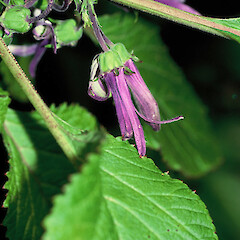Lobelia physaloides
Common name
colensoa, koru
Synonyms
Colensoa physaloides (A.Cunn.) Hook.f.; Pratia physaloides (A.Cunn.) Hemsley
Family
Campanulaceae
Flora category
Vascular – Native
Endemic taxon
Yes
Endemic genus
Yes
Endemic family
No
Structural class
Trees & Shrubs - Dicotyledons
NVS code
The National Vegetation Survey (NVS) Databank is a physical archive and electronic databank containing records of over 94,000 vegetation survey plots - including data from over 19,000 permanent plots. NVS maintains a standard set of species code abbreviations that correspond to standard scientific plant names from the Ngä Tipu o Aotearoa - New Zealand Plants database.
COLPHY
Chromosome number
2n = 26
Current conservation status
The conservation status of all known New Zealand vascular plant taxa at the rank of species and below were reassessed in 2017 using the New Zealand Threat Classification System (NZTCS) – more information about this can be found on the NZTCS website. This report includes a statistical summary and brief notes on changes since 2012 and replaces all previous NZTCS lists for vascular plants.
Please note, threat classifications are often suggested by authors when publications fall between NZTCS assessment periods – an interim threat classification status has not been assessed by the NZTCS panel.
- Conservation status of New Zealand indigenous vascular plants, 2017 . 2018. Peter J. de Lange, Jeremy R. Rolfe, John W. Barkla, Shannel P. Courtney, Paul D. Champion, Leon R. Perrie, Sarah M. Beadel, Kerry A. Ford, Ilse Breitwieser, Ines Schönberger, Rowan Hindmarsh-Walls, Peter B. Heenan and Kate Ladley. Department of Conservation. Source: NZTCS and licensed by DOC for reuse under the Creative Commons Attribution 4.0 International licence.
2017 | Threatened – Nationally Vulnerable | Qualifiers: PD
Previous conservation statuses
2012 | At Risk – Declining | Qualifiers: PD
2009 | At Risk – Relict | Qualifiers: PD
2004 | Gradual Decline
Brief description
Rare large soft herb with clusters of long tubular purple flowers inhabiting coastal forest of the northern North Island. Leaves large, soft, with many small teeth along margin. Flower base a green cup and on purple fuzzy stalks. Fruit a non-fleshy 10–15 mm wide blueish or white capsule.
Distribution
Endemic. New Zealand: Manawatāwhi / Three Kings Islands, North Island (from Te Paki to about Whangarei and Trounson Kauri Forest, Poor Knights Islands, Hen Island / Taranga Island, Rakitu Island). Its remote presence on Rakitu Island off the eastern side of Great Barrier Island suggests that it was probably more widespread on the mainland than the current distribution suggests.
Habitat
Coastal and lowland forest. Often along stream sides, or in damp sites in half-shade. Formerly common in these types of habitats within the more northerly kauri (Agathis australis) forest remnants.
Detailed description
Densely branched shrub up to 1 × 1 m. Basal stems and rootstock woody. Branches and branchlets erect to spreading, square in cross-section, green or purple, softly hairy. Petioles stout, fleshy, up to 100 mm long. Leaves alternate, (50)–70–150–(200) × (30)–40–60–(100) mm, membraneous, dark green to green, broad-ovate to ovate-oblong or elliptic oblong, apex acute to subacuminate, glabrescent, or finely hairy, with hairs concentrated on veins, leaf margins coarsely serrate. Inflorescences terminal racemes, (5)–10–15–(20)-flowered. Peduncles pubescent. Flowers on slender, pubescent, pedicels 20 mm long; bracts linear. Calyx lobes 8 mm, narrow-triangular to filiform, ciliolate. Corolla pubescent, 30–50 mm long, violet, dark blue, or rarely white; lower lip 3-toothed, upper deeply 2-cleft. Fruit a subglobose berry, 10–15 mm diameter, blue, white with blue spots or streaks or white. Seed 0.6–0.9 mm, broadly elliptic, broadly obovate or circular, orange to orange-brown.
Similar taxa
None
Flowering
May flower throughout the year. However plants are mostly found in flower between August and January
Flower colours
Blue, Violet/Purple
Fruiting
Fruit may be present throughout the year. However, they are more common between November and March
Life cycle
Fleshy berries are dispersed by invertebrate frugivory (Thorsen et al., 2009).
Propagation technique
Easy from fresh seed and cuttings. Very fast growing and ideal in semi-shaded to shaded spots under trees, especially along stream sides. An excellent pot plant.
Threats
As a high palatable herb this species has virtually vanished from most of its former mainland habitat. It remains abundant on islands free of browsing animals (such as Manawatāwhi / Three Kings Islands and Poor Knights Islands). On the mainland, plants can be found in locations inaccessible to browsing animals, such as boulder falls and cliff faces and in any location where prolonged animal control or human traffic has reduced or limited the affect of these creatures. If animal browse is removed this species can make a spectacular recovery.
Etymology
lobelia: Named after Lobel, pioneer botanist
physaloides: Like a cape gooseberry
Taxonomic Notes
The generic position of this species has long been debated with various treatments accepting its placement in Lobelia, Pratia or the monotypic Colensoa. The most recent view advocated by Lammers (2011) is that this species is best treated as a Lobelia.
Attribution
Fact Sheet prepared for NZPCN by P.J. de Lange 1 August 2003. Description based on Allan (1961) .
References and further reading
Allan HH. 1961. Flora of New Zealand, Volume I. Indigenous Tracheophyta: Psilopsida, Lycopsida, Filicopsida, Gymnospermae, Dicotyledones. Government Printer, Wellington, NZ. 1085 p.
Lammers TG. 2011. Revision of the infrageneric classification of Lobelia L. (Campanulaceae: Lobelioideae). Annals of the Missouri Botanical Garden 98(1): 37–62. https://doi.org/10.3417/2007150.
Thorsen MJ, Dickinson KJM, Seddon PJ. 2009. Seed dispersal systems in the New Zealand flora. Perspectives in Plant Ecology, Evolution and Systematics 11: 285–309. https://doi.org/10.1016/j.ppees.2009.06.001.
NZPCN Fact Sheet citation
Please cite as: de Lange, P.J. (Year at time of access): Lobelia physaloides Fact Sheet (content continuously updated). New Zealand Plant Conservation Network. https://www.nzpcn.org.nz/flora/species/lobelia-physaloides/ (Date website was queried)














